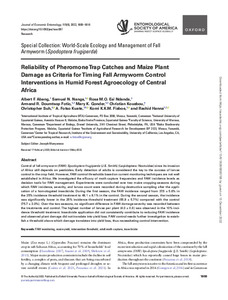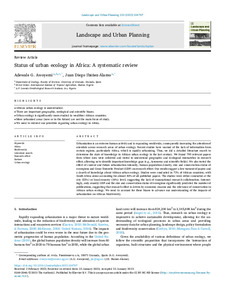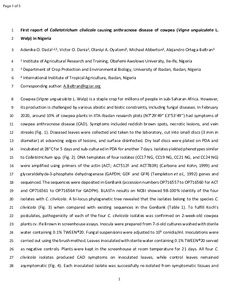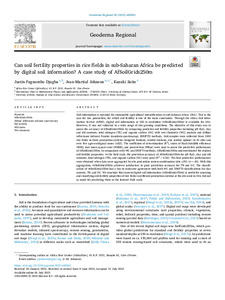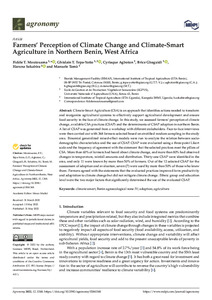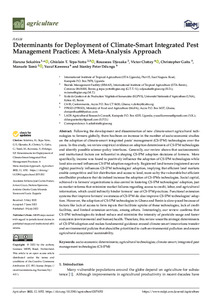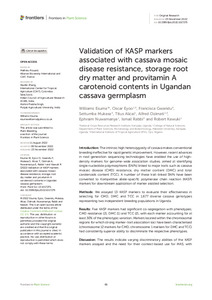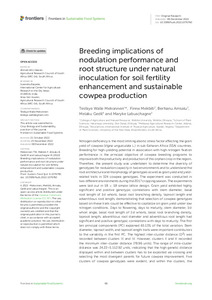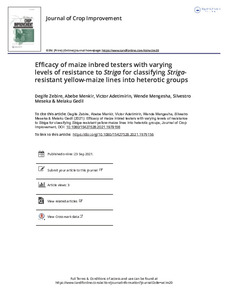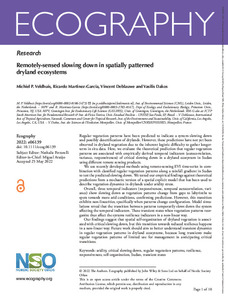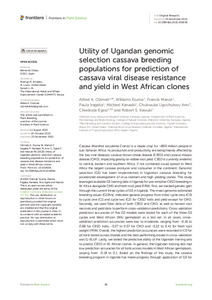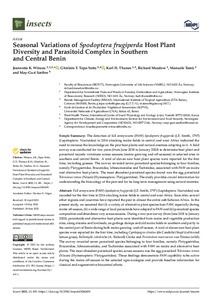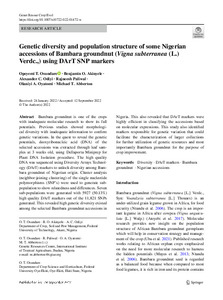Welcome to the International Institute of Tropical Agriculture Research Repository
Journal and Journal Articles: Recent submissions
Now showing items 321-340 of 5157
-
Reliability of pheromone trap catches and maize plant damage as criteria for timing fall armyworm control interventions in humid forest agroecology of central Africa
(2022)Control of fall armyworm (FAW) Spodoptera frugiperda (J.E. Smith) (Lepidoptera: Noctuidae) since its invasion of Africa still depends on pesticides. Early detection of adults is considered the key to the success of larvae control in the crop field. However, FAW control thresholds based on current monitoring techniques are not well established in Africa. We investigated the efficacy of moth capture frequencies and FAW incidence levels as decision tools for FAW management. Experiments were conducted ... -
Status of urban ecology in Africa: a systematic review
(2023-05)Urbanization is an extreme human activity and is expanding worldwide, consequently increasing the attention of scientists across research areas of urban ecology. Recent studies have warned of the lack of information from certain regions, particularly Africa, which is rapidly urbanizing. Thus, we did a detailed literature search to determine the state of knowledge in African urban ecology in the last century. We found 795 relevant papers from where data were collected and tested to understand ... -
Smallholder farmers' perception and challenges toward the use of crop residues and agro-industrial byproducts in livestock feeding systems in eastern DR Congo
(2022-07)The extent of crop residues and agricultural byproducts utilization for their integration in feeding systems in Eastern DR Congo was assessed in South-Kivu (Walungu territoire) and two territoires in the Tanganyika province (Kalemie and Moba territoires). Data were collected through 21 focus group discussions in which 273 farmers participated including respectively 116 (42%) from South Kivu and 157 (58%) from Tanganyika province. A logistic regression model was used to determine factors influencing ... -
Micro-climatic variations across Malawi have a greater influence on maize susceptibility to aflatoxins than to fumonisins
(2022-11-29)This study reports levels of aflatoxin and fumonisin in maize samples (n = 1294) from all agroecological zones (AEZs) in Malawi. Most maize samples (> 75%) were contaminated with aflatoxins and 45% with fumonisins, which co-occurred in 38% of the samples. Total aflatoxins varied across the AEZs, according to mean annual temperature (P < 0.05) of the AEZs. Samples from the lower Shire AEZ (median = 20.8 µg/kg) had higher levels of aflatoxins (P < 0.05) than those from the other AEZs (median = 3.0 ... -
First report of Colletotrichum cliviicola causing anthracnose disease of cowpea (Vigna unguiculata L. Walp) in Nigeria
(2022-12-21)Cowpea (Vigna unguiculata L. Walp) is a staple crop for millions of people in sub-Saharan Africa. However, its production is challenged by various abiotic and biotic constraints, including fungal diseases. In February 2020, around 10% of cowpea plants in IITA-Ibadan research plots (N7°29'49'' E3°53'49'') had symptoms of cowpea anthracnose disease (CAD). Symptoms included reddish brown spots, necrotic lesions, and vein streaks (Fig. 1). Diseased leaves were collected and taken to the laboratory, ... -
Impact of frequency of application on the long-term efficacy of the biocontrol product Aflasafe in reducing aflatoxin contamination in maize
(2022)Aflatoxins, produced by several Aspergillus section Flavi species in various crops, are a significant public health risk and a barrier to trade and development. In sub-Saharan Africa, maize and groundnut are particularly vulnerable to aflatoxin contamination. Aflasafe, a registered aflatoxin biocontrol product, utilizes atoxigenic A. flavus genotypes native to Nigeria to displace aflatoxin producers and mitigate aflatoxin contamination. Aflasafe was evaluated in farmers’ fields for 3 years, under ... -
Spatial and temporal population dynamics of Aspergillus flavus in commercial pistachio orchards in Arizona
(2022-06-09)Aspergillus flavus infects a wide range of crops, including pistachio, and subsequent aflatoxin contamination results in significant economic losses. Application of biocontrol products based on nonaflatoxigenic (atoxigenic) strains of A. flavus is one of the most effective tactics for controlling aflatoxins in crops. Both risk of aflatoxin contamination and effectiveness of biocontrol are influenced by the extent to which A. flavus spores move into pistachio tree canopies during periods of nut ... -
Can soil fertility properties in rice fields in sub-Saharan Africa be predicted by digital soil information? A case study of AfSoilGrids250m
(2022)Soil information is essential for sustainable agricultural intensification in sub-Saharan Africa (SSA). This is the case for rice production, for which soil fertility is one of the main constraints. Through the Africa Soil Information Service (AfSIS), digital soil information at 250 m resolution (AfSoilGrids250m) is available for SSA. However, it was not validated in a wide range of rice-growing conditions. The objective of this study was to assess the accuracy of AfSoilGrids250m by comparing ... -
Assessing the performance and participation among young male and female entrepreneurs in agribusiness: a case study of the rice and maize subsectors in Cameroon
(2021-03-02)The role played by youth in agriculture cannot be overemphasized, while agribusinesses are important generators of employment and income worldwide. Improving the sustainability of food value chains can benefit millions of rural poor people living in developing countries, especially young women. Despite policies and programs aimed at encouraging agricultural entrepreneurs, they are still facing challenges such as high-cost agrochemicals, limited access to credit, price volatility, etc. which seriously ... -
Farmers' perception of climate change and climate-smart agriculture in northern Benin, west Africa
(2022-05-31)Climate-Smart Agriculture (CSA) is an approach that identifies actions needed to transform and reorganize agricultural systems to effectively support agricultural development and ensure food security in the face of climate change. In this study, we assessed farmers’ perception of climate change, available CSA practices (CSAP) and the determinants of CSAP adoption in northern Benin. A list of CSAP was generated from a workshop with different stakeholders. Face-to-face interviews were then carried ... -
Determinants for deployment of climate-smart integrated pest management practices: a meta-analysis approach
(2022-07-19)Following the development and dissemination of new climate-smart agricultural technologies to farmers globally, there has been an increase in the number of socio-economic studies on the adoption of climate-smart integrated pests’ management (CS-IPM) technologies over the years. In this study, we review empirical evidence on adoption determinants of CS-IPM technologies and identify possible science-policy interfaces. Generally, our review shows that socioeconomic and institutional factors are ... -
Estimating genetic gains for tolerance to stress combinations in tropical maize hybrids
(2022-12-08)Maize is a strategic food crop in sub-Saharan Africa. However, most maize growing tropical savannas particularly in West and Central African experience the occurrence of frequent droughts and Striga infestation, resulting in 30–100% yield losses. This production zones need maize cultivars that combine tolerance to the two stresses. IITA in collaboration with national partners has thus employed a sequential selection scheme to incorporate both drought tolerance and Striga resistance in topical maize ... -
Validation of KASP markers associated with cassava mosaic disease resistance, storage root dry matter and provitamin A carotenoid contents in Ugandan cassava germplasm
(2022-11-23)Introduction The intrinsic high heterozygosity of cassava makes conventional breeding ineffective for rapid genetic improvement. However, recent advances in next-generation sequencing technologies have enabled the use of high-density markers for genome-wide association studies, aimed at identifying single nucleotide polymorphisms (SNPs) linked to major traits such as cassava mosaic disease (CMD) resistance, dry matter content (DMC) and total carotenoids content (TCC). A number of these trait-linked ... -
Breeding implications of nodulation performance and root structure under natural inoculation for soil fertility enhancement and sustainable cowpea production
(2022-12-08)Nitrogen deficiency is the most limiting abiotic stress factor affecting the grain yield of cowpea (Vigna unguiculata L.) in sub-Saharan Africa (SSA) countries. Breeding for high-yielding potential in association with high nitrogen fixation performance is the principal objective of cowpea breeding programs to improve both the productivity and production of this orphan crop in the region. Therefore, the present study was undertaken to determine the diversity of genotypes for nodulation capacity in ... -
Efficacy of maize inbred testers with varying levels of resistance to Striga for classifying Striga-resistant yellow-maize lines into heterotic groups
(2021-09-23)Identifying efficient testers for separating maize (Zea mays L.) inbred lines into heterotic groups can facilitate the development of superior hybrids. Striga-resistant yellow-maize inbred lines developed at the International Institute of Tropical Agriculture (IITA) do not have well established heterotic groups. This study was conducted to identify efficient testers for classifying yellow-maize inbred lines into heterotic groups. Thirty Striga-resistant inbred lines were crossed with three testers ... -
Remotely-sensed slowing down in spatially patterned dryland ecosystems
(2022-10)Regular vegetation patterns have been predicted to indicate a system slowing down and possibly desertification of drylands. However, these predictions have not yet been observed in dryland vegetation due to the inherent logistic difficulty to gather longer-term in situ data. Here, we evaluate the theoretical prediction that regular vegetation patterns are associated with empirically derived temporal indicators (autocorrelation, variance, responsiveness) of critical slowing down in a dryland ecosystem ... -
Utility of Ugandan genomic selection cassava breeding populations for prediction of cassava viral disease resistance and yield in West African clones
(2022-11-23)Cassava (Manihot esculenta Crantz) is a staple crop for ~800 million people in sub-Saharan Africa. Its production and productivity are being heavily affected by the two viral diseases: cassava brown streak disease (CBSD) and cassava mosaic disease (CMD), impacting greatly on edible root yield. CBSD is currently endemic to central, eastern and southern Africa, if not contained could spread to West Africa the largest cassava producer and consumer in the continent. Genomic selection (GS) has been ... -
Seasonal variations of Spodoptera frugiperda host plant diversity and parasitoid complex in southern and central Benin
(2022)Fall armyworm (FAW) Spodoptera frugiperda (J.E. Smith, 1797) (Lepidoptera: Noctuidae) was recorded for the first time in 2016 attacking maize fields in central and west Africa. Soon after, several other regions and countries have reported the pest in almost the entire sub-Saharan Africa. In the present study, we assumed that (i) a variety of alternative plant species host FAW, especially during maize off-season, (ii) a wide range of local parasitoids have adapted to FAW and (iii) parasitoid species ... -
Genotype-environment-interaction and stability of root mealiness and other organoleptic properties of boiled cassava roots
(2022-12-03)Genetic enhancement of cassava aimed at improving cooking and eating quality traits is a major goal for cassava breeders to address the demand for varieties that are desirable for the fresh consumption market segment. Adoption of such cassava genotypes by consumers will largely rely not only on their agronomic performance, but also on end-user culinary qualities such as root mealiness. The study aimed to examine genotype × environment interaction (GEI) effects for root mealiness and other culinary ... -
Genetic diversity and population structure of some Nigerian accessions of Bambara groundnut (Vigna subterranea (L.) Verdc.,) using DArT SNP markers
(2022-09-24)Bambara groundnut is one of the crops with inadequate molecular research to show its full potentials. Previous studies showed morphological diversity with inadequate information to confirm genetic variations. In the quest to reveal the genetic potentials, deoxyribonucleic acid (DNA) of the selected accessions was extracted through leaf samples at 3 weeks old, using Dellaporta Miniprep for Plant DNA Isolation procedure. The high quality DNA was sequenced using Diversity Arrays Technology (DArT) ...

